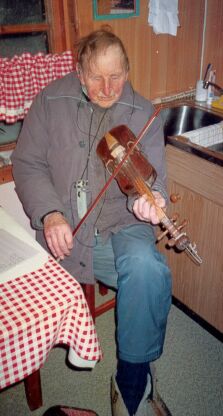

Johannes Berven (“Jóanes Trø’n”, 1899–1996) from the island of Tustna in the region of Nordmøre, Norway was a coastal peasant (US: farmer), blacksmith, postal clerk and fiddler. These pictures — taken in December 1995, when he was almost 97 years old — show the fiddle he built himself with some help from his father 75 years earlier, around 1910.
He played a few tunes to me that day, and I wrote them down. Amongst those tunes were a Polka, the beginning of “Kostervalsen” (which he played with many double stops and a very firm rhythm), “Den Trondhjemske madammen i raumåla hus” and a quite beautiful waltz which he refused to append any name or source to. I suspect very strongly that this waltz, which now goes under the name “Vals etter Johannes Berven” (“Waltz after Johannes Berven”), is actually his own composition.
Another tune after Johannes is “Salmå-as Berven” (“Berven’s Psalm”). This tune — a “paríser” — Johannes Hals played to me a few days after I visited Johannes Berven, so that I could write it down. Johannes Hals was of the opinion that this tune was Johannes Berven’s own composition.
The side (“siå”) are sawn out of one piece of wood; the back (“punnifjøla”) and the front (“oppåfjøla”) are made from a pine board which was discarded from the siding of the house. There is no basebar in the fiddle. The neck (“hášn”) is also made from pine, and his father helped him shape that part. The fingerboard (“nótbrætte”) is made from beech. A carpenter helped him level it with the correct curvature. The bridge (“spælhæstn”) is a regular modern violin bridge. The strings are of a pretty common type for the beginning of the 20th century: steel e", gut a' and d', and spun gut g. Johannes used this fiddle for many years, until he bought a regular violin. After that, he mostly played on his modern violin, but when I visited him on the morning of 24 December 1995, he took out his old fiddle, so that I could take some pictures of it.
When Johannes Berven was 90 years old, he decided that it was time for him to learn how to read music. Accordingly, he sat down with his fiddle and a song book and started figuring it all out by himself; he started with tunes he knew, and when he had found out what locations on the staff corresponded to what pitches on the fiddle, he started to teach himself new tunes from that book and a couple other song books.



Skrivarstuå
©1995–2005
Olve Utne
(The music is the intellectual property of Johannes Berven’s heirs.)
Oppdatert (Updated)
28 September 2005 -
25 Elúl 5765